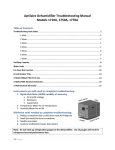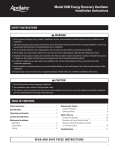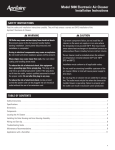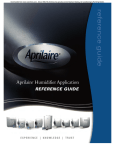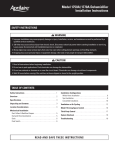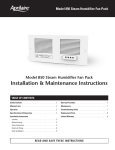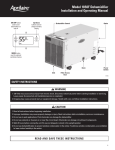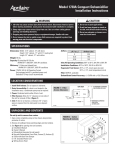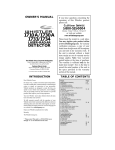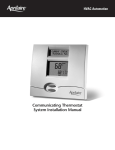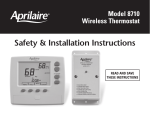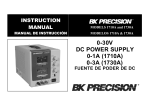Download Aprilaire 1730A Specifications
Transcript
Model 76 Dehumidifier Control Installation Instructions READ AND SAVE THESE INSTRUCTIONS The Model 76 is for use with any dehumidifier as an EXTERNAL CONTROL, including Aprilaire Models 1710A, 1730A, 1750A, 1770A. The Model 76 can also be used as a communicating REMOTE CONTROL with Aprilaire Models 1710A, 1750A, 1770A. (See OVERVIEW on page 3 for details.) Safety Instructions WARNING 1. Improper installation may cause property damage or injury. Installation, service, and maintenance must be performed by a qualified service technician. 2. 120 Volts may cause serious injury from electric shock. Disconnect electrical power before starting installation or servicing. Leave power disconnected until installation/service is completed. This control is not a 120 Volt (line voltage) device. CAUTION 1. Read all instructions before beginning installation. 2. Do not use in pool applications. Pool chemicals can damage the control. 3. Do not use solvents or cleaners on or near the display and circuit board. Chemicals can damage components. 1 Table of Contents Safety Instructions . . . . . . . . . . . . . . . . . . 1 Overview . . . . . . . . . . . . . . . . . . . . . . . . . . . 3 Specifications . . . . . . . . . . . . . . . . . . . . . . 3 Location Recommendations . . . . . . . . . . 4 Installation Mount Control . . . . . . . . . . . . . . . . . . . . . 5 Replacing a 1730A Manual Dehumidistat . . . . . . . . . . . . . . 6 Wiring to 1730A . . . . . . . . . . . . . . . . . . . . 8 Wiring to 1710A/1750A/1770A External Control . . . . . . . . . . . . . . . . . . . 9 Remote Control . . . . . . . . . . . . . . . . . . 10 OVERVIEW System Checkout Power Up . . . . . . . . . . . . . . . . . . . . . . . . Test Mode . . . . . . . . . . . . . . . . . . . . . . . . Humidity/Dryness Level Setting . . . . . . Offset . . . . . . . . . . . . . . . . . . . . . . . . . . . Turning On and Setting the Control . . . . Sequence of Operation External Control . . . . . . . . . . . . . . . . . . Remote Control . . . . . . . . . . . . . . . . . . 11 13 13 13 14 15 15 Troubleshooting Error Codes External Control . . . . . . . . . . . . . . . . . . 16 Remote Control . . . . . . . . . . . . . . . . . . 16 Troubleshooting Guide . . . . . . . . . . . . . . 18 The Aprilaire® Model 76 Dehumidifier Control provides control of the dehumidifier from the living space. The control can be installed as an EXTERNAL CONTROL, allowing the homeowner to set and adjust the humidity setting and turn dehumidification on or off from a convenient location. In this application, the Model 76 uses an onboard sensor to monitor the relative humidity (%RH) in the space in which it is located and displays the measured relative humidity on the digital display. The control can also be installed to function as a REMOTE CONTROL if the dehumidifier is located where it is not easy or convenient to access. The control can be installed in any location within the living space, with the dehumidifier installed in the area to be dehumidified, such as a crawl space, attic, or basement. The dryness level is set on the control and communicated to the dehumidifier. The dehumidifier communicates the measured relative humidity in the space being dehumidified back to the Model 76 Control where it is displayed on the digital display. SPECIFICATIONS 2 ELECTRICAL External Remote Input Voltage and Current Voltage: 24VAC +/-20% Current: 25mA (nominal), 50mA (max.) at 24VAC Voltage: 9VDC (supplied by dehumidifier control board) Output Dry Contact, Normally Open Communication (RS485) CONTROL External Remote Control Range 40% – 80% RH 1 (less dry) – 7 (more dry) 65°F – 40°F Dew Point Accuracy +/-5% RH Differential 3% Low Limit 40°F Dew Point 50°F Dry Bulb High Limit 99°F Dry Bulb 105°F Dry Bulb See Dehumidifier Specifications 3 LOCATION RECOMMENDATIONS INSTALLATION As a REMOTE CONTROL, the Model 76 can be mounted wherever is convenient for the homeowner. MOUNT CONTROL Follow the recommendations below when installing the Model 76 as an EXTERNAL CONTROL. MOUNT CONTROL •In an area the homeowner wants to monitor and control moisture levels. •On an interior wall. If replacing a control mounted in the living space, see Control Mounted in Living Space on page 6. DO NOT MOUNT CONTROL Figure 2 – Disassemble Control • In the flow of a supply register. •Behind doors, in corners or other dead air spaces. •Approximately 5’ off the floor. •In direct sunlight, near lighting fixtures, or other appliances that give off heat. •At least 18” from an outside wall. •On an outside or unconditioned area wall. T AR AP LL PU A B C/R/+ DH DH •In stairwells or near outside doors. •On a wall with concealed pipes or ductwork. BACKING PLATE Figure 1 – Mounting Control FRONT COVER 90-1631 Figure 3 – Mount Backing Plate ANCHOR 90-1640 A B C/R/+ DH DH BACKING PLATE SCREW 90-1632 4 5 Required Components If the control is mounted on A 1730A dehumidifier: 18 – 24 gauge wire (field supplied) – 4 wires required, run new cable as needed. (2) #8 x 1-1/2” mounting screws (supplied) (2) Anchors (supplied) NOTE: The Model 76 is installed in the living space and not on the dehumidifier. See LOCATION RECOMMENDATIONS on page 4. 1.Level the backing plate on the wall and mark the mounting holes and wire access location on the wall. 2.Pull knob from the dehumidistat cover and remove cover from the control base. 1. Disconnect power to the dehumidifier and HVAC system. 2.Drill two 3/16” mounting holes and a 3/4” wire access hole. See Figure 3. 3.Remove the four screws from the base plate and pull the dehumidistat off the unit until 4”– 6” of wire is outside of the unit. 3.Install the drywall anchors flush with the wall surface. Note: Mounting holes on the backing plate are designed to fit on a horizontal J-box. 4.Cut the wires and use metal tape to secure the leads to the inside of the unit, preventing contact with the blower. 4.Run a 4-wire cable from the dehumidifier to the wall mount location and through the square hole in the backing plate. 5.Remove the gasket from the base plate. 5.Secure the backing plate to the wall using the two #8 x 1-1/2” screws. REPLACING A 1730A MANUAL DEHUMIDISTAT 6.Install the insulated cover plate (Service Part 4927) and gasket over the opening, using the screws removed in step 3. See Figure 5. 7.Remove the wiring access panel on the outlet panel. See Figure 6. 8.Unplug the REMOTE terminals from the circuit board, remove the two wires and cut off the bare leads. Once cut, the wires may remain in the unit. STEP 1 – Remove the Current Manual Control 9.Replace REMOTE terminals on circuit board and leave wiring access panel off for Model 76 wiring. If the control is mounted in the living space: 10.Proceed to WIRING section on page 8. Figure 4 – Manual Dehumidistat 1. D isconnect power to the dehumidifier and HVAC system. 2.Pull knob from the dehumidistat cover and remove cover from the control base. Figure 5 – Inlet with Cover Plate COVER PLATE SERVICE PART 4927 Figure 6 – Wiring Access Panel on Outlet WIRING ACCESS PANEL 3.Remove the four screws from the base plate. 4.Pull the dehumidistat off the wall until wire nuts are exposed. 5.Remove dehumidistat leads. 6.The existing 2-wire cable can remain. The Model 76 wiring requires 4 wires. Install more wires as needed. 7.Mount the Model 76 control following steps 1-5 in the MOUNT CONTROL section above. Reuse the existing wire access hole and wiring as needed. 8.Connect the existing wires (from 1730A REMOTE terminals) to the DH terminals and connect the remaining two wires to the C/- and R/+ terminals on the Model 76 backing plate. 9.Push excess cable into the wire access hole and fill the hole with insulation. Note: Failure to seal the hole can cause drafts to enter the control and affect sensing accuracy. 90-1642 90-1633 10.Proceed to WIRING section on page 8. 6 7 MODEL 76 EXTERNAL CONTROL TO 1710A /1750A /1770A WIRING 1.Disconnect power to the dehumidifier and HVAC system. STEP 2 – Supply 24VAC To The Model 76 Control The Model 76 control requires 24VAC when installed as an EXTERNAL CONTROL for the 1730A. Pulling power from the HVAC system is the recommended method. 3.Connect one wire from the DH terminal on the Model 76 to the DH terminal on the control board. 4.Connect the other wire from the DH terminal on the Model 76 to the Rf terminal on the control board. 5.Connect the wires from the C/- and R/+ terminals on the Model 76 to the HVAC or thermostat C and R terminals. 6.Set SYSTEM SETUP switch to EXTERNAL. See Figure 9. 7.Replace the control door on the dehumidifier. 8.Snap the Model 76 front cover on the backing plate. The 6-pin terminal aligns with the terminal block receptacle on the backing plate. Figure 8 – Model 76 External Control to 1710A/1750A/1770A Wiring DEHUMIDIFIER CONTROL BOARD EXISTING WIRING C G W W Y Y DH Figure 7 – Model 76 to 1730A Wired to HVAC System Wiring Note: The dehumidifier Rf and Cf terminals must be powered from the transformer that powers the Model 76 Control. EXISTING WIRING ADDITIONAL MODEL 76 WIRING A B C/R/+ DH DH ON C G 4 R 3 R/+ DH HVAC EQUIPMENT R 2 A B C/- THERMOSTAT SYSTEM SETUP LOCAL HVAC FAN OFF PRIMARY VENT-AUTO EXTERNAL HVAC FAN ON PRIMARY/SECONDARY VENT-TIMED 90-1538 A B + Rf Cf Gs Gh W DH FLOAT ODT SWITCH SENSOR REMOTE HVAC EQUIP MODEL 76 Figure 9 – Model 76 External Control Dip Switch Configuration 1 ADDITIONAL MODEL 76 WIRING VENT DEH DAMPERS MODEL 76 TO 1730A 1. Disconnect power to the dehumidifier and HVAC system. 2. If replacing a dehumidistat that was in the living space, follow steps 3-6. If replacing a dehumidistat that was on the dehumidifier, follow steps 7-13. 3. Connect the wires from the C/- and R/+ terminals on the Model 76 to the HVAC or thermostat C and R terminals. 4. Connect the existing wires connected to the REMOTE terminals to the DH terminals on the Model 76. 5. Snap the Model 76 front cover on the back plate. The 6-pin terminal aligns with the terminal block receptacle on the back plate. 6. Proceed to SYSTEM CHECKOUT on page 11. 7. Remove the wiring access panel (if not already removed) on the dehumidifier outlet panel. 8. Unplug the REMOTE terminals from the circuit board. 9. Connect the wires from the DH terminals on the Model 76 to the REMOTE terminals and plug the terminals back into the unit circuit board. 10.Connect the wires from the C/- and R/+ terminals on the Model 76 to the HVAC or thermostat C and R terminals. 11.Replace the wiring access panel on the dehumidifier. 12.Snap the Model 76 front cover on the backing plate. The 6-pin terminal aligns with the terminal block receptacle on the backing plate. 13.Proceed to SYSTEM CHECKOUT on page 11. 2.Remove the control door on the dehumidifier inlet panel. 90-1537 THERMOSTAT R C G W Y HVAC EQUIPMENT R C G W Y FLOAT SWITCH REMOTE G-STAT R-HVAC G-HVAC 90-1641 8 9 MODEL 76 REMOTE CONTROL TO 1710A /1750A /1770A SYSTEM CHECKOUT 1.Disconnect power to the dehumidifier and HVAC system. 2.Remove the control door on the dehumidifier inlet panel. POWER UP 3.Connect one wire from the A terminal on the Model 76 to the A terminal on the control board. 1.Check all wiring. 2.Plug in dehumidifier and restore power to the HVAC system. 4.Connect one wire from the B terminal on the Model 76 to the B terminal on the control board. 5.Connect one wire from the R/+ terminal on the Model 76 to the + terminal on the control board. 3.Turn on/off switch on dehumidifier ON. After a 4 second start up sequence all buttons on the Model 76 will be functional. • The control will be OFF. 6.Connect one wire from the C/- terminal on the Model 76 to the – terminal on the control board. • The humidity setting will be 60% if wired for EXTERNAL CONTROL. The dryness level will be set to 3 if REMOTE CONTROL. 7.Set SYSTEM SETUP switches to LOCAL and PRIMARY, See Figure 11. • The control will display the measured humidity. – EXTERNAL CONTROL displays humidity measured by the control in it’s installed space. – REMOTE CONTROL displays humidity measured by the dehumidifier in it’s installed space. 8.Replace the control door on the dehumidifier. 9.Snap the Model 76 front cover on the backing plate. The 6-pin terminal aligns with the terminal block receptacle on the backing plate. Figure 10 – Model 76 Remote Control to 1710A/1750A/1770A Wiring DEHUMIDIFIER CONTROL BOARD ON 4 LOCAL HVAC FAN OFF PRIMARY VENT-AUTO 3 90-1537 Humidity Setting and Offset Adjustment SYSTEM SETUP 2 R/+ DH Rf Cf Gs Gh W DH FLOAT ODT A B + HVAC EQUIP SWITCH SENSOR REMOTE A B C/- Model 76 Control Figure 11 – Model 76 Remote Control Dip Switch Configuration 1 VENT DEH DAMPERS MODEL 76 Figure 12 – External Control EXTERNAL HVAC FAN ON PRIMARY/SECONDARY VENT-TIMED 90-1538 Control must be ON to adjust offset and setting. Measured Humidity or Setting Control On/Off Model 76 LCD Display SET: Shows when humidity setting displayed or being changed. Solid ON: Control On Blinking ON: Dehumidifying DH OFF: Control Off * Blinking ON + : Control Limit Exceeded. See Control Limits, page 15. 90-1636 10 11 Figure 13 – Remote Control TEST MODE Model 76 Control 1.Press and hold the ON button for 5 seconds to enter Test Mode. a. Verify the measured humidity is displayed on the Model 76 screen. Dryness Level b. Verify dehumidifier turns on, and ON blinks on the Model 76 screen. Control must be ON to adjust. c. Verify the is displayed on the Model 76 screen when wired as a REMOTE CONTROL. * 2.After 5 minutes or after pressing the OFF button, the control will enter Off mode. a. Verify the dehumidifier turns off. Measured Humidity in Remote Location or Dryness Level Setting Control On/Off Model 76 LCD Display Does not display when setting dryness level Solid ON: Control On Blinking ON: Dehumidifying OFF: Control Off 90-1636 SET: Shows when dryness level setting displayed or being changed. HUMIDITY / DRYNESS LEVEL SETTING •The control must be ON to adjust the humidity or dryness level setting. •The (up) and (down) buttons are used to increase or decrease the setting. •The first press of either button will display the current setting and SET on the LCD display. •Each subsequent push of the up or down buttons will change the setting by 1% or 1 dryness level. •If a button is held down, the setting will continually change by 1% or 1 dryness level every 1/2 second for as long as the button is pressed. •The control will return to Normal Mode, displaying the measured humidity, 5 seconds after the last button press/release. OFFSET When the Model 76 is installed as an EXTERNAL CONTROL, an offset can be applied to the humidity reading to avoid discrepancies with other humidity measuring devices in the home. Allow 48 hours for the control to acclimate before applying an offset. The control must be ON to enter the Offset screen. Figure 14 – Offset Screen NOTE: This feature is not available when the control is installed as a REMOTE CONTROL. •Press and hold the OFF button for 5 seconds to enter the Offset screen. 90-1638 •The buttons can be used to set an offset value between -5% RH and +5% RH. •The control will return to Normal Mode, displaying the measured humidity, 5 seconds after the last button press/release. 12 13 TURNING ON AND SETTING THE CONTROL SEQUENCE OF OPERATION External Control External Control 1.Press the ON button. Normal Mode 2.Use the buttons to set the control at 59%. Increasing the humidity setting will decrease dehumidifier run time, allowing for higher humidity levels. Decreasing the humidity setting will increase dehumidifier run time, allowing for lower humidity levels. TABLE 1 – %RH (+/-5%) Based on Dryness Remote Control Level Setting & Indoor Temperature 1.Press the ON button. buttons to set the 2.Use the control to a 3 dryness level. Increasing the dryness level will increase dehumidifier run time, allowing for lower humidity levels. Decreasing the dryness level will decrease dehumidifier run time, allowing for higher humidity levels. The dryness level settings can be approximated to relative humidity (%RH) using Table 1. Dryness Level Setting Indoor Temperature (°F) 65 1 70 75 80 84% 71% 60% 2 86% 73% 61% 52% 3 74% 63% 53% 45% 4 64% 54% 45% 39% 5 55% 46% 39% 33% 6 47% 39% 33% 28% 7 40% 34% 28% 24% Note: This table is for reference only. •When the measured humidity is greater than the setting, the control will activate the dehumidifier output, the dehumidifier will begin dehumidifying and ON will blink on the LCD display. •When the measured humidity falls 3% below the setting, the control will deactivate the dehumidifier output, the dehumidifier will stop dehumidifying and the LCD will display a solid ON. Control Limits •If the control measures a dew point below 40°F OR a temperature above 99°F, the control will deactivate the dehumidifier output if actively dehumidifying, the dehumidifier will stop dehumidifying, and ON and will blink on the LCD screen. •The control will resume normal operation when the measured dew point is greater than 45°F or the measured temperature is below 94°F, whichever control limit was exceeded. * Remote Control Normal Mode •Once during every Cycle Period (set by the dip switches in the dehumidifier) the dehumidifier blower and dehumidifier damper output will turn on and sample the air in the area served by the dehumidifier. Sampling will also occur whenever the dryness level setting is increased on the Model 76 Control. •After three minutes, the dew point of the incoming air is measured and compared to the dryness level set on the Model 76 Control. If the dew point of the incoming air is above the setting, the compressor turns on and ON will flash on the Model 76 screen. •The dew point of the incoming air is continuously monitored during compressor operation. When the dew point of the incoming air falls below the dryness level setting, the dehumidifier compressor and blower will turn off and ON will stop flashing on the Model 76 screen. Control Limits The control limits are determined by the dehumidifier. •If the dehumidifier senses incoming air below 50°F or above 105°F, the dehumidifier will stop compressor operation if actively dehumidifying and ON will stop flashing on the Model 76 screen. •The dehumidifier will resume normal operation when the measured incoming air to the dehumidifier is between 55°F and 100°F. 14 15 TABLE 2 – Error Codes TROUBLESHOOTING Technical Support is available Monday through Friday, 7:00 a.m. to 5:00 p.m. CST, at (800) 334-6011. Use the guide on the following page to help find and correct system faults. Contact Technical Support before replacing the control or for additional troubleshooting. Model 76 Error Code Failure Mode E1 Fault Type Failure Condition Action Internal dehumidifier RH sensor fault. Critical RH sensor nonexistent, erratic or reads out of 0% 100% range. 1.Check connection between dehumidifier sensor board and control board. 2.If connection okay, replace sensor board, Part No. 4752. E2 Internal dehumidifier temperature sensor fault. Critical Temperature sensor non-existent, erratic or reads out of -20°F – 150°F range. 1.Check connection between dehumidifier sensor board and control board. 2.If connection okay, replace sensor board, Part No. 4752. E3 Model 76 Remote Control fault. Critical Model 76 Remote Control not communicating with dehumidifier. 1.Check connections between Model 76 and dehumidifier control board. 2.If connections are correct and secure, turn off the dehumidifier and remove the Model 76. Use a short section of 4-wire cable to reconnect the Model 76 to the control board. Turn the dehumidifier back on and increase the dryness level setting on the Model 76. If the dehumidifier turns on, the problem is with the wiring between the dehumidifier and control. 3.If the dehumidifier does not turn on, call Technical Support. E4 Dehumidifier insufficient capacity Critical After 20 minutes of compressor operation, the frost sensor temperature is not at least 5°F below the inlet air temperature. E6 Dehumidifier frost sensor failure. Critical Frost temperature sensor non-existent, erratic or reads out of -20°F – 150°F range. 1.Check the frost sensor connection at the dehumidifier control board. 2.Remove the side panel of the dehumidifier and verify the temperature sensor is not damaged, is fully inserted in the sensor well, and the well is filled with thermal paste. 3.If the sensor is not damaged and positioned correctly, contact Technical Support. E7 Dehumidifier float switch open. Non-Critical Open circuit between float switch inputs. ERROR CODES External Control When the control detects an internal error, it will stop controlling, deactivate the dehumidifier output, and the LCD will display the Error Code. See Figure 15. The control will attempt to recover from the error every 10 minutes. The Error Code will continue to be displayed as long as the error condition exists. Button presses are not registered when in Error Mode. Cycling power to the control will not clear the code and the control will need to be replaced. Figure 15 – External Control Error Code Screen 90-1645 Remote Control When there is a dehumidifier or control communication fault, all dehumidifier outputs will turn off and the Model 76 LCD will display an Error Code. See Figure 16 for an example. The faults can either be critical or non-critical. When a critical fault is detected, all dehumidifier outputs will Figure 16 – Remote Control Error Code Screen immediately turn off. A critical fault is cleared by repairing the fault and cycling power using the on/off switch on the dehumidifier. When a non-critical fault is detected, the dehumidifier will revert to limited operation. A non-critical fault is cleared by repairing the fault and cycling power to the dehumidifier is not required. See Table 2 for 90-1645 the error codes and required action. 16 1.Empty the condensate pan (if applicable). 2.Check the float switch connection at the control board. 3.If not using a float switch, verify the jumper is between the float switch terminals on the dehumidifier control board. 4.If the problem persists, replace the float switch. 17 TABLE 3 – Troubleshooting Guide Symptom Possible Reason Troubleshooting Procedure No power to the control. Incorrect wiring. Verify wiring connections between control, dehumidifier and HVAC system (where applicable). No power to dehumidifier. • Verify that the dehumidifier power switch is ON. • Verify the circuit breaker has not tripped. No power to HVAC equipment. • Verify HVAC system switch is on. • Verify the circuit breaker has not tripped. Control does not turn on dehumidifier output. Incorrect wiring. Verify wiring connections between control and dehumidifier. Blank display or missing segments during Test mode. LCD error. Replace control. Display shows EE. Control detected an internal error. The control will need to be replaced. Display shows E1-E7. Dehumidifier or communication error. Use Table 2 to troubleshoot fault. Inaccurate humidity reading when using External Control. Control recently installed after being stored in an uncontrolled temperature and humidity environment. Allow 48 hours for control to acclimate. Offset has been applied to the humidity reading. Change the offset. Control is mounted in direct sunlight, above a heat or humidity source, or in the path of a supply register. Relocate the control. 18 P.O. Box 1467 • Madison, WI 53701-1467 • Phone: 800/334-6011 • Fax: 608/257-4357 www.aprilairepartners.com 10009850 2.12 B2205738A Printed in U.S.A. © 2012 Aprilaire – A division of Research Products Corporation











